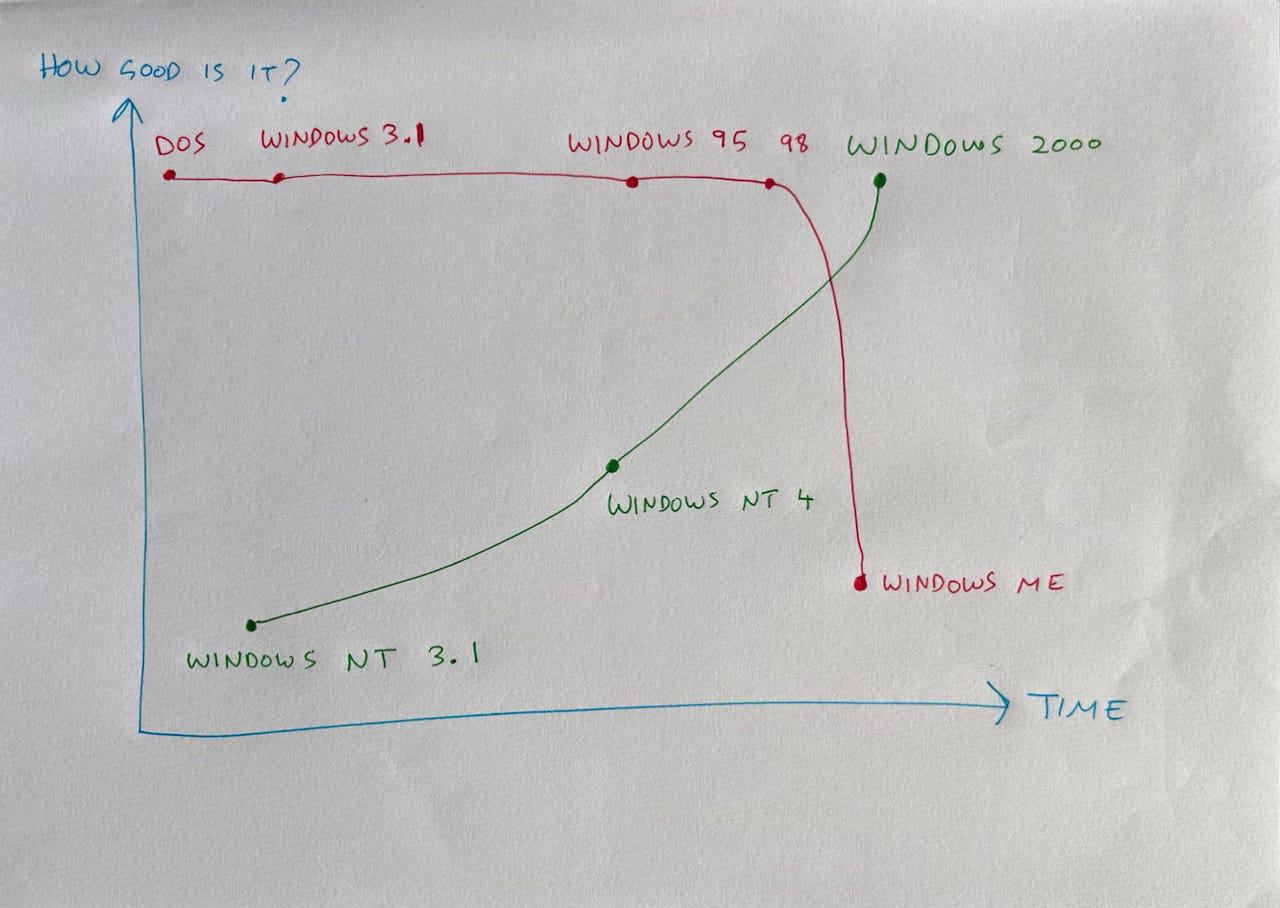Which Windows versions were #1?
Which versions of Windows were #1 in usage at any time in their life? In other words, was there a time when a given version of Windows had more active users than all other versions?
I first thought that would be the case for every version, but the wider market is not comprised of geeks who want the best. Many people are content sticking with what they have, even if it’s sub-optimal, upgrading only when there’s a huge improvement. Likewise for companies. So only some versions reach #1.
And these were:
3.1 → 95 → XP→ 7 → 10
Let’s look at some versions of Windows in detail to see what we can learn:
Windows 95
made it to #1. It was a completely different user experience, much more polished and intuitive. The apps were also more sophisticated. We were in another era of computing. And Microsoft marketing did an excellent job of creating awareness. Everyone in tech, or who was interested in tech, or who used computers heard about how computers are now going to work at another level. There was a huge amount of hype. It was as if aliens had landed on earth and given us the next generation of technology.
Windows 98
didn’t make it to #1. It wasn’t fundamentally different over 95 the way 95 was over 3.1. But there were a number of improvements that made everyday use better — you wouldn’t want to go back to 95 after using 98. Despite the significant improvement in the day to day user experience, people were lazy enough to stick with 95 :(
Windows 2000
didn’t make it to #1. I feel sad about this, because it was my favorite version of Windows. Microsoft had two operating system families:
The Legacy family: DOS → Windows 3.1 → 95 → 98. This is shown in red in the graph below.
NT (New Technology) family: Windows NT 3 → NT 4 → 2000. This is depicted in green.
Initially, the legacy family was the best choice. The NT family had unreasonably high hardware requirements:
Windows NT 4.0 requires a Pentium PC with 32MB of RAM. It should not be run on a PC with less than 32MB, nor should it be run on a 486 with 32MB of RAM.
This was at a time when the computer I used to use with Windows 95 didn’t have a Pentium, and had only 8 MB memory. 32 MB was beyond our imagination. It’s like a 200-inch TV!
The NT family was also compatible with fewer programs1. And installing hardware was harder. New technology is initially immature and overpriced2. It requires a gestation period of years3.
By the era of Windows 2000, the legacy family had outlived its usefulness. People had enough of it crashing all the time. The bugs in NT had been worked out by then, and it would never crash. Having a tool I could count on work no matter what I threw at it was a great feeling. It had cutting-edge technology like protected memory, so one program couldn’t corrupt the memory of another program or the OS. And preemptive multitasking, so that if one program hung, it wouldn’t hang the whole system. And multithreading, so a single program could do multiple things at once. And multiple cores. Windows 2000 was cutting-edge technology.
With cheaper hardware, it was the first time that the stability and power of the NT family became available on hardware that was affordable. This is when I switched, but the majority of users weren’t smart or fast enough to recognise this. So Windows 2000 didn’t make it to #1.
Windows XP
… made it to #1. It was a more polished version of Windows 2000, with the same stability but a better user experience, as Windows 98 was to 95.
After Windows XP, I used a Mac for multiple years. It was much more intuitive, had less friction, it was more responsive, faster and beautiful. It was at another level of quality, built by people who cared about it. Even the Mac OS X installer was better than the core Windows XP user experience. Windows became a poor man’s choice. Microsoft didn’t even seem to know what game they were playing, and what parameters they were being judged on.
I eventually returned to Windows in the era of:
Windows 10
… which made it to #1. I found that by the time of Windows 10, Microsoft had hugely improved Windows. It was intuitive. It booted up quickly. It didn’t require frequent reboots like the old Windows did. On a scale of 0 to 10, where 10 is macOS, Windows XP was 5, and Windows 10 was 9. But it was still not as beautiful as macOS, not to mention the hardware, like the 1600-nit HDR screen, the excellent trackpad, 3 Thunderbolt ports, or the wonderful responsiveness and performance of the M series SoCs. I continue to use the Mac.
… as apps were called in those days.
In parallel with developing the NT family as the long-term solution, Microsoft kept improving the legacy family, backporting features like preemptive multitasking and multithreading to Windows 95.
Microsoft chose the right strategy of investing heavily in NT development for years despite it having fewer users, knowing that one day, it will take over. And it did.


